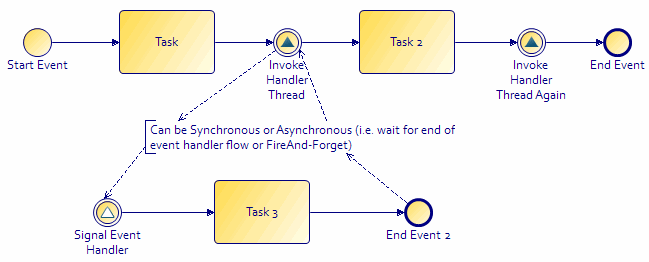Signal Event Handlers
An event handler flow can be triggered from within the same process instance using signal events. The signal event handler flow can be executed asynchronously or synchronously with the invoking flow (the invoking flow generally waits at the throw-signal event for the completion of the event handler flow before continuing). This allows process designers to define and re-use complex sets of repeatable activities.
The catch signal event Properties tab contains Event Handler configuration controls (which are shown only when the catch signal is an event handler (with no incoming flow).
The default setting is Wait at the invoking signal until event handler flow is complete. This setting controls whether the throw signal's outgoing flow is processed after the event handler flow. If you unset this flag it can be processed without waiting.
Note that:
- Signal event handlers can also be used within embedded sub-processes. Place the signal event handler inside the embedded sub-process. This will ensure that the embedded sub-process local data is in scope of the signal event handler flow.
- Signal event handlers can be used within pageflow processes.
- Case data signal event handlers allow a process to subscribe to a particular case object that the process uses. The process will then be notified if that case object is modified, and can take appropriate action to respond to the change. See "Notifying a Process That a Case Object It Uses Has Been Modified" in the TIBCO ActiveMatrix BPM Case Data User's Guide for more information.

